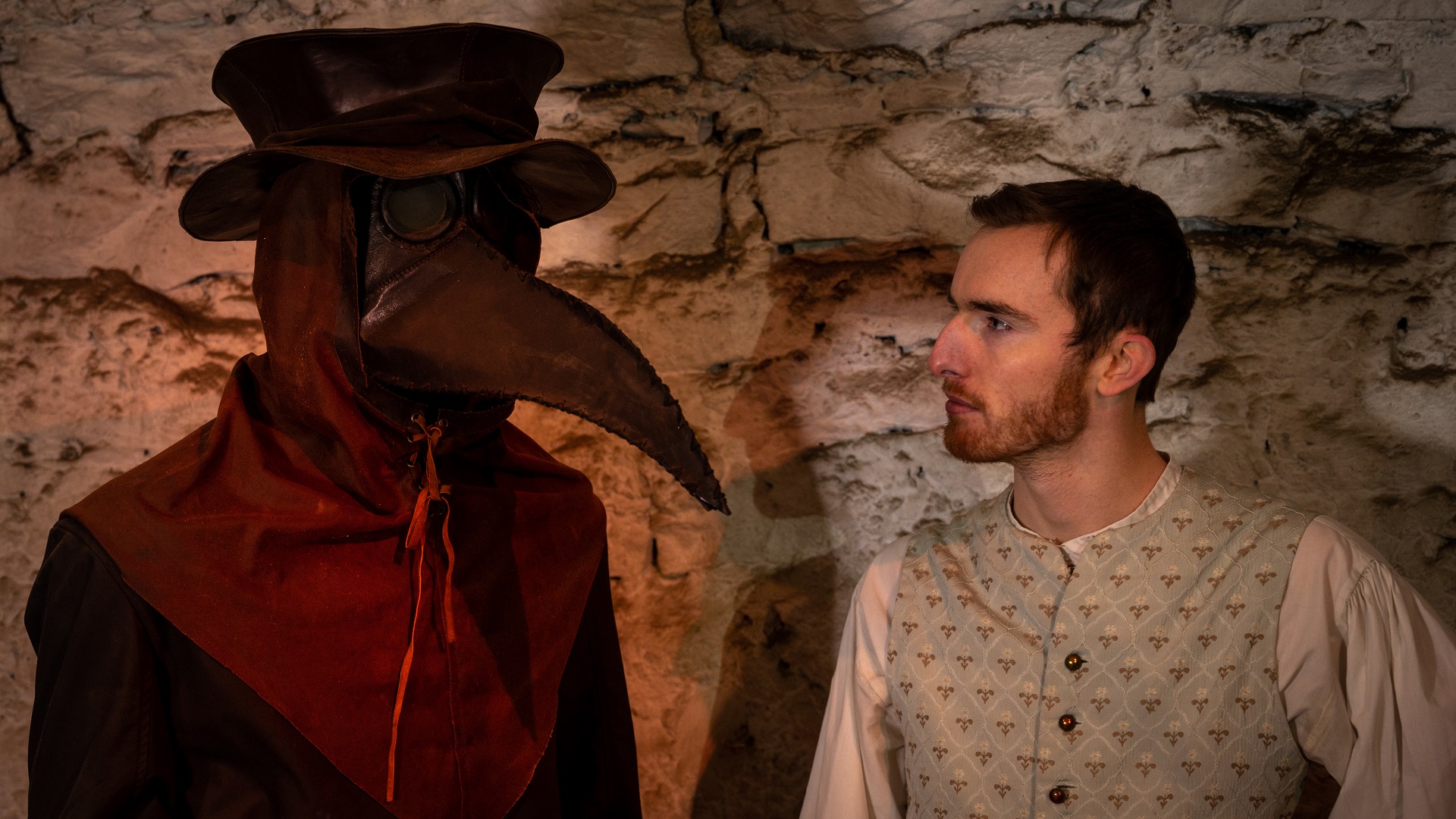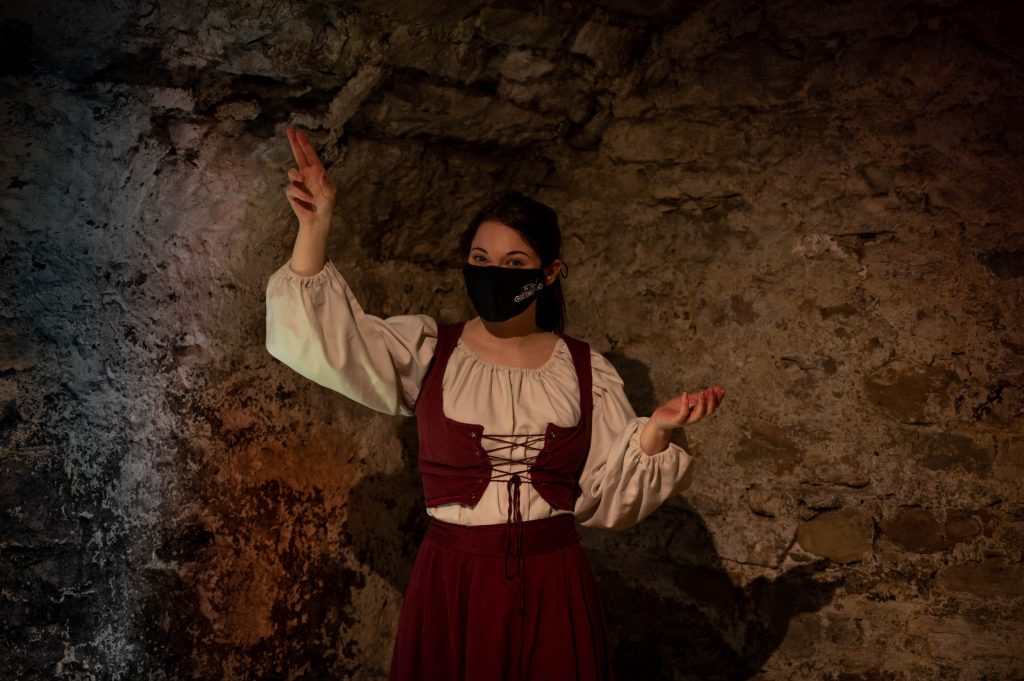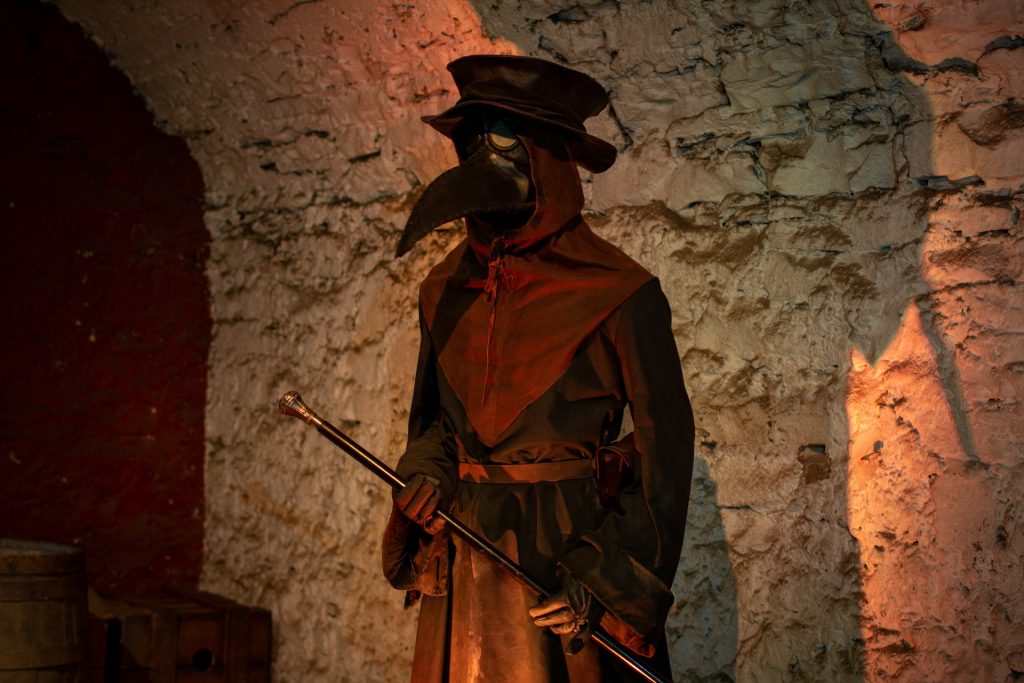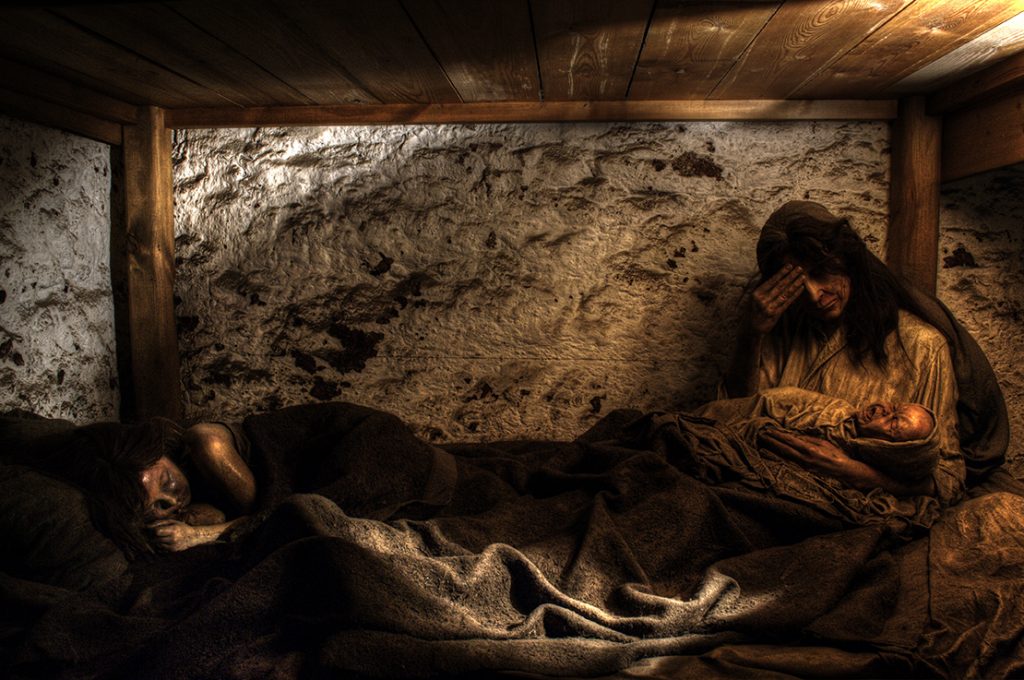Epidemics from 1645 until Now: Old Problems, Same Solutions?

Edinburgh’s Plague Doctor, George Rae, pictured with a resident on The Close © The Real Mary King’s Close
Earlier this year The Real Mary King’s Close broadcast a live virtual tour, including insights into famous epidemics through the centuries. The special was filled with interesting findings from our knowledgeable guides and fellow history buffs. One certain history buff, Dr Aaron Allen, is a Scottish History Expert from The University of Edinburgh. He decided to go one step further and compare the epidemics of 1645 to now, detailing how “the same old problems, sometimes require the same old solutions”.
We’re delighted to present Dr Aaron Allen’s findings. There are some truly striking parallels between the experience felt by the residents of Mary King’s Close and the reality we have all been subjected to over the last year and a half.
The Parallels
From October 1644 to October 1649, a series of epidemic outbreaks happened in Scotland. While other diseases were present, much of this is thought to have been bubonic plague, transferred, in theory, by flea bites.
For Edinburgh, 1646 was the last serious year of plague outbreak. In 2020, we faced another terrible outbreak of disease. Whilst our current troubles can be better described as a global pandemic, and have several important differences from the seventeenth-century disease, there are still certain parallels in our approaches to tacking it. As outlined below…

1. Social Distancing
Isolation
In both 2020 and 1645, the most effective weapon against epidemic disease has proven to be social distancing.
Today, we’ve had to adjust to restrictions on our movement. However, we can rely on social media to keep us up to date with exactly how much distance we need to keep. In 1645 they also sought to restrict movement, relying on guards outside infected homes; a nightly town watch; and the expensive system of town walls and ports.
When someone was found to be sick, they were often sent out of the town to isolation ‘huts’ or ‘lodges’ on the Boroughmuir (the Meadows). Alternatively, they were sent to Sciennes. Leith had huts set up where you will find the Links there today. The Canongate also had huts in the King’s Park.
Indeed, such isolation in plague lodges was standard practice, as seen at Paisley, Stirling, Perth, Glasgow and Aberdeen.
Closure of public services
Other forms of social distancing were also observed. Edinburgh’s courts were closed until January 1646, when the danger ebbed in winter. Churches in Leith were also closed. Weddings were affected. Penny bridals, which were a popular form of wedding reception, were forbidden.
While cancelled celebrations are a restriction of personal liberty we have in common with the 1600s, the similarities don’t stop there. In both eras, restrictions also impacted the fates of those with no liberty. Certain prisoners have been released early, for example, to limit the spread of the virus in close quarters. So too were debtors released from prison in 1645 .
2. Cleanliness
In 2021, one of the earliest and most important messages was to wash hands carefully, with every school child singing ‘Happy Birthday’ as they went about their task. While the popular perception of the seventeenth-century is a complete lack of hygiene, one of their responses to epidemic disease was also to improve cleanliness. In 1645 ‘cleaners’ were appointed to take away refuse and waste, and they were given power to punish disobeyers. While this does suggest that the streets were full of waste, it also shows they understood that this worsened the problems of disease. In Leith, muck and dead swine were removed from the streets, and houses were fumigated with burning heather. Other towns, such as Aberdeen, went further, ordering the killing of cats and dogs, and the poisoning of mice and rats.
While handwashing has been emphasised in 2020, one of our main problems has been the lack of personal protective equipment (PPE) for those dealing with the sick. Likewise, PPE was a concern in 1645, with the Edinburgh council paying for clothes, slippers and badges to be made for the plague cleaners appointed by the council. While they may not have understood germ theory or what bacteria are, they did see clearly the importance of cleanliness.
3. Education
For parents, one of the more difficult aspects of the Covid crisis is juggling working from home with the requirements of homeschooling. While this only affects those with school-aged children, the potential impact on the education of an entire generation of our societies makes this a very real problem for all of us. While we have the advantages of the internet and online education tools, the schools of 1645 were simply shut. On 16th April 1645 the High School was ‘dissolved’ until 20th May, but actually remained closed until March 1646.17 Nearby towns such as Canongate also shut their schools.
Higher education was also affected. The University of Edinburgh, or the ‘Town’s College’, demitted, as did the University of St Andrews. ‘Public laureations’, or graduation ceremonies, were also stopped, and due to the continuing crises of war, were not to resume at Edinburgh until April 1655. Whilst in 2020 we have simply moved university lectures and tutorials online, using ‘Collaborate’ for digital classes, the response in 1645 was more conventional, with the Town College being moved to Linlithgow. Reassuring as this was, many parents chose not to send their children.

4. Disruption of Trade and Business
Just as current restrictions threaten to bring a collapse of the global economy, with both unemployment and underemployment, so too the 1645 plague meant economic crisis. This can be seen in the town accounts, where the yield of the ‘common good’ was down by half in places, and wholly gone at other times. Such downturn in town revenue reflects the wider ‘standstill’ in the markets. As plague deaths increased, it was no longer deemed safe to bring produce to sell in the capital’s markets. Grain prices in Haddington, for example, plummeted as stocks failed to reach Edinburgh’s corn (grain) market. The glut in supply could not be vented to the capital’s consumers, regardless of the continuous demand. In the short term this brought dearth and famine, though in the longer term there was actually a decrease in pressure on resources, with corn prices dropping by 1650. In other towns, traders made their transactions outside of town but boiled the coins they received in brass ladles to avoid the plague. In 2020, we simply transitioned to online payments, prompting the media to muse about whether Covid-19 will be the end of cash transactions. Will we use the pound coin again? What impact will this have on the poor?
5. Access to Food
Just as we’ve seen empty shelves in our supermarkets in 2020, so too the 1645 plague brought dearth to the markets that Edinburgh burgesses and indwellers depended on. In both cases, this was largely a problem of distribution. Today, many blame panic buyers, but what is more problematic is the necessary changes to the way we buy. While most flour used to be bought in bulk by bakeries, schools, coffee shops, and the like, which distributed the flour as baked goods to their customers, now the same consumers are trying to buy that flour in small bags for home baking. The system simply isn’t geared up to sell the flour in that way. This led to empty shelves, but plenty of flour at the mills – who simply don’t have the right quantity of small-sized bags to satisfy the new customer demand.
In 1645, there were also problems with distribution. Food was still being produced in the countryside, but as the urban markets were unsafe due to infection, they collapsed and famine started to bite for the survivors in the town. This was amplified in the summer – the traditional time of hunger – as household stocks were running down in anticipation of the harvest. But due to the pestilence, many chose not to take their harvest produce to Edinburgh markets in the autumn of 1645. In response, a committee was set up to advise the council on ‘furnishing the Toun’ with meat and drink. There were riots in the jail due to lack of food, and voluntary contributions were needed to provide for the poor who were, ‘inclosed or infected with the contagion of the pest’. In Leith, money was taken from the dead to be used for the destitute and cattle on links whose owners had died were slaughtered to feed the poor. As with 2020, the usual system which had worked so well in 1644 now required new approaches.
6. Social Inequity
Just as ethnic and gender factors are disproportionately represented in Covid-19 deaths, plague victims were also disproportionately represented. While the rich could flee to country villas, the poor had nowhere to go. While ethnic divisions appear to have been less pronounced in the seventeenth-century, class divisions were acute. Such inequities can be studied in 2020, but unfortunately it is difficult to gather concrete quantitative data for 1645. Qualitative evidence is clear, though, with an act of council in 1645 demanding that all burgesses and inhabitants remain in the town – an act with certain parallels to the lockdown of 2020. It was complained that ‘sundry neighbours’ had selfishly fled, leaving the rest of the town to fend for itself. While this flight of the citizens was problematic, on 27th October 1645 a proclamation showed something far worse: several of the council themselves had actually abandoned their posts:
‘Ordaines the wholl counselleris and magistratts who ar absent to repair and reside within this brugh with all diligence with certificatioun of ane rigid cours to be taken agains them…’.33
This proclamation had to be issued again the next February, showing that the problem of government officials ignoring their own lockdown rules is not just a twenty-first-century issue.
7. Dealing with the Dead
One terrible aspect of epidemic disease is the traditional problem of how we deal with the remains of victims. Edinburgh’s council hired grave makers in early June of 1645 – and then appointed more twenty days later. Aside from the dangers posed to staff, traditional methods of burial also proved inadequate, so emergency measures were needed. In 2020, East Lothian planned to use its salt storage facility for storing the dead from Covid, which thankfully has not yet been needed. In 1645 the Lothians did have need, and therefore mass graves were made. Edinburgh purchased a quarry on the Boroughmuir from the merchant, Robert Gray. This is likely to be under the golf course on Bruntsfield Links, as the depressions represent a disused quarrying landscape. Canongate’s mass grave was on St Leonard’s Hill, while Leith’s were on the Links. Smaller villages nearby, such as Duddingston, also needed mass graves. Duddingston saw an eight fold increase in burials in 1645. Unfortunately, mass graves are not a thing of the past. Recent scenes from Hart Island in New York City of mass graves being dug by prisoners remind us of the dangers of epidemic disease in an urban environment.
From October 1644 to October 1649 a series of epidemic outbreaks were visited upon Scotland. While other diseases were present, much of this is thought to have been bubonic plague, transferred in theory by flea bites. For Edinburgh, 1646 was the last serious year of plague outbreak, despite preparations in the city when the ‘Great Plague of London’ began to kill so many. In 2020 we faced another terrible outbreak of disease. Whilst our current troubles are a global pandemic, with several important differences from the seventeenth-century disease, still there are certain parallels in our approaches, as outlined below.

Learnings and Lessons:
While there are many differences between the experience of epidemic disease in 1645 and in 2020, there are also clear parallels. In some ways, the recovery from the 1645 outbreak was relatively quick. For example, demographically, recovery was not slow. Comparing the towns baptisms to its burials suggest that about 87 per cent of the drop in the population level was recovered through the births. While this does not take away from the tragedy of 1645, it does show resilience in the face of continued crisis as the country carried on through the civil wars. Recovery came at a tremendous financial cost, leaving aside the human cost. Taxation was needed to get society back on its feet, and 70,000 merks was sought by the town council. What is less clear is what lessons were learned by the seventeenth-century survivors. Fortunately, their records allow us to take lessons away – especially when reflecting on the similarities between their experiences and ours in 2020.
Discover the stories of the people who lived, worked and died in 17th Century Edinburgh. Step down into Edinburgh’s hidden history through a guided tour, book a visit to The Real Mary King’s Close.









